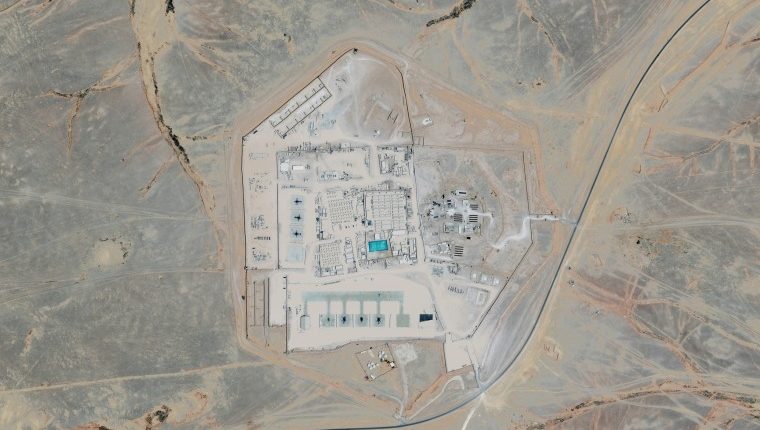ERBIL, Iraq — U.S. forces have multiple targets to pick from as they prepare a forceful response to the deaths of three American service members in a drone attack in Jordan, experts say. But after Washington has hinted of retaliatory strikes for days, Iran-backed militant groups across the Middle East have had plenty of time to ready themselves.
American forces are expected to hit targets in countries outside Iran in response to last Sunday’s drone strike, U.S. officials told NBC News on Thursday. The operation will likely be President Joe Biden’s most forceful response yet to militia groups that have launched more than 160 attacks against U.S. forces since the war between Israel and Hamas started in Gaza on Oct. 7.
“At this point, it’s time to take away even more capability than we’ve taken in the past,” Defense Secretary Lloyd Austin said Thursday at a news conference. How much Tehran knew about the attack on the Tower 22 in Jordan that killed Spc. Kennedy Sanders, Spc. Breonna Moffet and Sgt. William Jerome Rivers “really doesn’t matter because Iran sponsors these groups,” he added.
“Without that facilitation, these kinds of things don’t happen,” Austin said of the strike, which also injured more than 30 service members and which the U.S. has attributed to the Islamic Resistance in Iraq, an umbrella group of Iran-backed militias that includes the militant group Kataib Hezbollah.

Both Iraq and Syria are home to hundreds of Iran-linked military sites, according to Charles Lister, a senior fellow at the Middle East Institute, a Washington-based think tank.
“The list of potential targets is enormous,” he said.
For example, the towering, glass-fronted Beit Al Zajaja office block at the Damascus International Airport in Syria, called the “Glass House,” is known to be a key Iranian command center, Lister said. He added that the Dimas air base to the west of the city is also known to be a major Iranian drone-making facility.
The vast Imam Ali base at Al Bukamal on Syria’s eastern border with Iraq contains hardened missile tunnels and an Iranian training camp and could house up 20,000 troops, said Lister, who frequently briefs the U.S. government on the situation inside Syria and Iraq.
In November the Middle East Institute tracked 200 targeted Israeli strikes on locations it said were known to harbor Iranian forces or affiliated militia in the past decade. It said many of the military industrial sites they hit were run by the Iranians. But it added that while strikes on airports in Damascus and Aleppo did put them out of action, they were only offline for a matter of days.
As the hours go by without U.S. action, Iran and its allies have been able to prepare, and a senior Iraqi official said Wednesday that Iran-backed militia groups were readying for the expected American strikes.
“Armed factions evacuated many of their headquarters inside Iraq and on the border with Syria and moved their weapons to new locations for fear of being targeted by the Americans,” the official said.
The official said that Brig. Gen. Esmail Ghaani, the head of Iran’s secretive Quds Force, part of the Revolutionary Guard, traveled to Iraq’s capital, Baghdad, this week and met with leaders of the factions making up the Islamic Resistance in Iraq.
Ghanni, who replaced Gen. Qassem Soleimani after he was killed in 2020 by a U.S. drone strike on Baghdad airport, told them to “reduce the military escalation against U.S. forces and calm the security situation,” the official added.
Lister said it was understandable that the militant groups would go to ground as they awaited America’s response, “to not pop their heads up from the parapet and offer the U.S. targets.”
However, Myles Caggins, a retired U.S. colonel who served in Iraq, cautioned that the militants were still active, even if they were taking cover. “They’re still maneuvering, they’re still collecting intelligence. they’re still planning additional strikes on U.S. targets,” said Caggins, who now runs the Words Warriors, a business consultancy service in the northern Iraqi city of Erbil.
And Akram al-Kaabi, the secretary general of the Nujaba Movement, another faction of Islamic Resistance in Iraq, also vowed Friday to fight until U.S. forces withdraw from Iraq and the Israel-Hamas war ends.
Previous U.S. strikes on Houthi rebels in Yemen and Iran-backed militias elsewhere in the region have failed to deter attacks on U.S. forces in the region, said Ali Vaez, the Iran project director at the International Crisis Group, a Belgian think tank focused on preventing wars.
“There’s a long track record of us using force to try to weaken and push back against Iran and its allies in the region, and it has almost never worked,” he said.
Vaez added that Iran was still able to supply explosive devices and knowhow to its proxies when the U.S. had a far bigger military footprint in Iraq and Afghanistan, both of which neighbor Iran.
“If the attack happens outside of Iranian soil, this is in line with the kind of cost that Iran is willing to absorb for the kind of confrontation that it has been in with the U.S. for decades now,” he said. “It knows that it’s the cost of doing business.”
But he cautioned that any counterattack that destroys Iranian assets or kills Iranian-backed militia fighters risks a tit-for-tat response that could draw the U.S. deeper into the region.
Iranian President Ebrahim Raisi said Friday that his country would not start a war but that it would “respond strongly” to anyone who tried to bully it.
And Ali said Iran could not “afford to back off when an attack happens because that would signal weakness. And the Iranians are allergic to demonstrating weakness because they believe that would only invite more aggressive action from Israel and the United States.”
“Both sides are climbing the escalatory ladder very quickly,” he added. “And they’re really at the mercy of a single mistake or miscalculation that could result in tensions spinning out of control.”
Keir Simmons and Mo Abbas reported from Erbil. Khalid Razak reported from Baghdad.
Source: | This article originally belongs to Nbcnews.com










